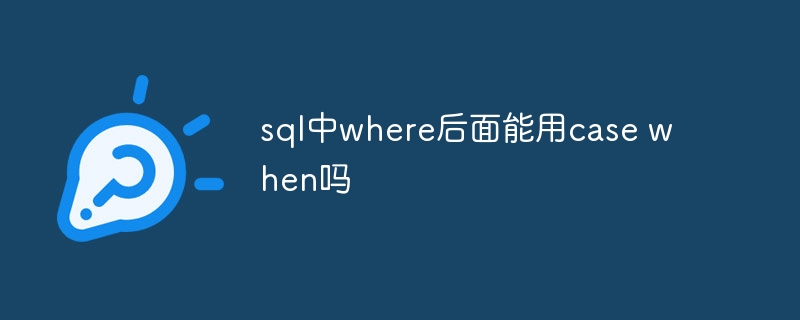Can case when be used after where in sql?
In SQL, CASE WHEN can be used in the WHERE clause. Used to specify different results when a condition is true or not true, thereby filtering data and selecting only rows that meet specific conditions. The syntax is: WHERE CASE WHEN
THEN WHEN THEN ... ELSE END.

Can CASE WHEN
in the WHERE clause of SQL be used in the WHERE clause? CASE WHEN?
Yes, you can use the CASE WHEN statement in the WHERE clause.
how to use?
The CASE WHEN statement is used to specify different results when a condition is true or not. In the WHERE clause, it can be used to filter data and select only rows that meet certain criteria.
Syntax:
<code>WHERE CASE
WHEN <condition1> THEN <result1>
WHEN <condition2> THEN <result2>
...
ELSE <default_result>
END</code>Example:
<code>SELECT * FROM table_name
WHERE CASE
WHEN age > 18 THEN 'Adult'
WHEN age BETWEEN 13 AND 18 THEN 'Teen'
ELSE 'Child'
END;</code>This query will select all from the table named "table_name" rows and classify them as "Adult", "Teen" or "Child" based on their "age" column.
Note:
- CASE WHEN can be used as an expression in the WHERE clause.
- Make sure to specify a default result to handle all cases where none of the conditions are met.
- CASE WHEN can be nested, allowing complex conditions.
The above is the detailed content of Can case when be used after where in sql?. For more information, please follow other related articles on the PHP Chinese website!

Hot AI Tools

Undresser.AI Undress
AI-powered app for creating realistic nude photos

AI Clothes Remover
Online AI tool for removing clothes from photos.

Undress AI Tool
Undress images for free

Clothoff.io
AI clothes remover

AI Hentai Generator
Generate AI Hentai for free.

Hot Article

Hot Tools

Notepad++7.3.1
Easy-to-use and free code editor

SublimeText3 Chinese version
Chinese version, very easy to use

Zend Studio 13.0.1
Powerful PHP integrated development environment

Dreamweaver CS6
Visual web development tools

SublimeText3 Mac version
God-level code editing software (SublimeText3)

Hot Topics
 What are the different types of data partitioning in SQL (horizontal, vertical)?
Mar 13, 2025 pm 02:01 PM
What are the different types of data partitioning in SQL (horizontal, vertical)?
Mar 13, 2025 pm 02:01 PM
The article discusses horizontal and vertical data partitioning in SQL, focusing on their impact on performance and scalability. It compares benefits and considerations for choosing between them.
 How to handle foreign key constraints in SQL delete rows
Mar 04, 2025 pm 05:52 PM
How to handle foreign key constraints in SQL delete rows
Mar 04, 2025 pm 05:52 PM
This article addresses deleting rows with foreign key constraints in relational databases. It details methods for handling constraint violations, including cascading deletes, restricting deletes, and setting nulls. The article emphasizes best pract
 How do I use aggregate functions in SQL to summarize data (SUM, AVG, COUNT, MIN, MAX)?
Mar 13, 2025 pm 01:50 PM
How do I use aggregate functions in SQL to summarize data (SUM, AVG, COUNT, MIN, MAX)?
Mar 13, 2025 pm 01:50 PM
The article explains how to use SQL aggregate functions (SUM, AVG, COUNT, MIN, MAX) to summarize data, detailing their uses and differences, and how to combine them in queries.Character count: 159
 What are the security risks of using dynamic SQL and how can I mitigate them?
Mar 13, 2025 pm 01:59 PM
What are the security risks of using dynamic SQL and how can I mitigate them?
Mar 13, 2025 pm 01:59 PM
The article discusses security risks of dynamic SQL, focusing on SQL injection, and provides mitigation strategies like using parameterized queries and input validation.
 What are the different transaction isolation levels in SQL (READ UNCOMMITTED, READ COMMITTED, REPEATABLE READ, SERIALIZABLE)?
Mar 13, 2025 pm 01:56 PM
What are the different transaction isolation levels in SQL (READ UNCOMMITTED, READ COMMITTED, REPEATABLE READ, SERIALIZABLE)?
Mar 13, 2025 pm 01:56 PM
The article discusses SQL transaction isolation levels: READ UNCOMMITTED, READ COMMITTED, REPEATABLE READ, and SERIALIZABLE. It examines their impact on data consistency and performance, noting that higher isolation ensures greater consistency but ma
 How to test SQL delete rows
Mar 04, 2025 pm 05:53 PM
How to test SQL delete rows
Mar 04, 2025 pm 05:53 PM
This article details effective testing strategies for SQL DELETE operations. It emphasizes verifying correct row deletion via pre- and post-deletion data comparisons, row counts, and negative testing. Best practices, including backups, transaction
 What are the ACID properties of transactions in SQL?
Mar 13, 2025 pm 01:54 PM
What are the ACID properties of transactions in SQL?
Mar 13, 2025 pm 01:54 PM
The article discusses the ACID properties (Atomicity, Consistency, Isolation, Durability) in SQL transactions, crucial for maintaining data integrity and reliability.
 What is the difference between SQL delete rows and truncate
Mar 04, 2025 pm 05:49 PM
What is the difference between SQL delete rows and truncate
Mar 04, 2025 pm 05:49 PM
This article compares SQL's DELETE and TRUNCATE commands. DELETE removes rows individually, allowing conditional removal and transaction rollback. TRUNCATE is faster, removing all rows at once, but lacks rollback capability. Performance and data re






